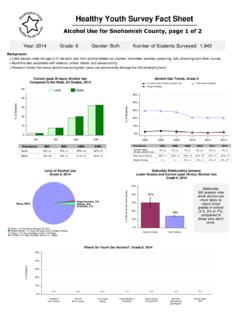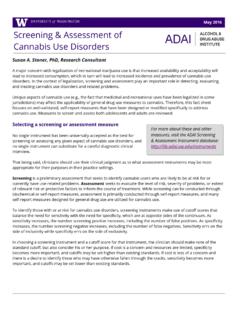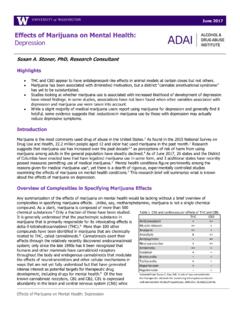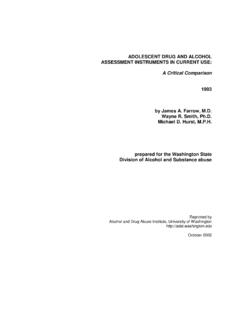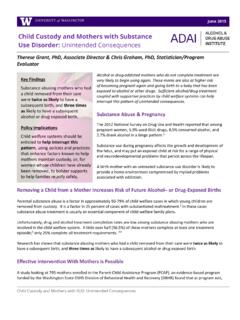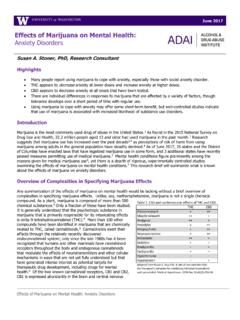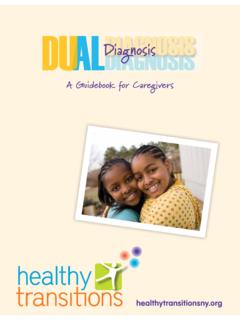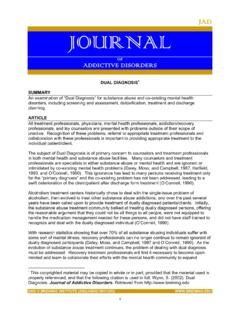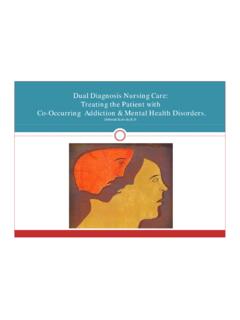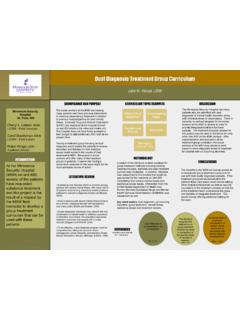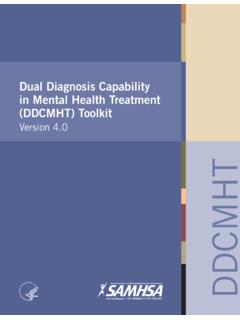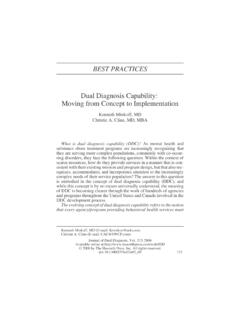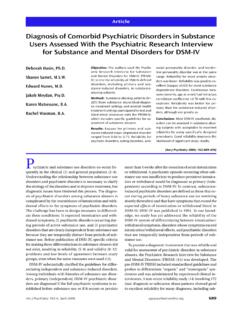Transcription of Co-Occurring Disorders in Adolescents - ADAI UW
1 1 A D A I-I B 2 0 1 1-01 INFO Brief This annotated bibliography describes a variety of resources on Co-Occurring Disorders in Adolescents . The terms Co-Occurring , co-morbid, and dual diagnosis are used to describe the condition of someone suffering from both a mental illness and a substance abuse problem. Making a dual diagnosis in substance abusers is difficult, as drug abuse itself often induces psychiatric symptoms, and has an impact on treatment planning. Counselor Magazine Daley DC, Marsili R. No One Left Unharmed: dual Disorders and the Family. Counselor 2005; 6(1):37-44. This article describes the nature of Co-Occurring Disorders in Adolescents and the impact these Disorders can have on the family as a whole. It presents a series of strategies to help counselors work with the entire family during the treatment process. Free online: Dyer F. Evidence-based treatment for Adolescents with Co-Occurring Disorders .
2 Counselor 2006;7(2):28-35. Increasingly, therapists are being asked to utilize evidence-based treatments when work-ing with Adolescents with Co-Occurring Disorders . How do you identify these practices and determine whether or not they are feasible for your program? Free online: Dyer FJ. Successful treatment for adolescent girls with substance abuse and depression. Counselor 2005;6(4):12-20. This article describes several issues all clinicians, therapists, counselors, criminal justice and mental health workers should be aware of when it comes to treating adolescent girls for Co-Occurring Disorders . Free online: Online Resources dual diagnosis in Adolescence Factsheet (National Alliance on Mental Illness) This factsheet defines dual diagnosis and provides information on its origins and treatment for caregivers and parents. dual diagnosis Website This site is designed to provide information and resources for service providers, consumers, and family members who are seeking assistance and/or education in this field.
3 Content by Kathleen Sciacca. Substance Abuse & Mental Health Administration (SAMHSA) Co-Occurring Disorders Website This website offers an array of resources on Co-Occurring Disorders for families, clinicians, and administrators or policy makers: Integrated Treatment for Co-Occurring Disorders Evidence-Based Practices (EBP) KIT. Provides practice principles about integrated treatment for Co-Occurring Disorders , an approach that offers mental health and substance abuse services at the same time and in one setting. Offers suggestions from successful programs. Substance Abuse Treatment For Persons With Co-Occurring Disorders Inservice Training based on Treatment Im-provement Protocol (TIP 42). This COD curriculum consists of 18 modules and includes presentation instructions, Power-Point slides (that can be copied onto overhead transparencies), trainer scripts, and participant handouts. The training approach includes presentations, discussion sessions, and practice exercises for participants.
4 At the Crossroads: Examining the Intersection of Care for Persons with Mental and Substance-Use Conditions. Webcast explores barriers to effective treatment for people with Co-Occurring Disorders . Includes recommendations for service coordination & steps to treatment improvement. More webcasts: Co-O c c u r r in g D i s o r d e rs in A d o le s c e n t s S e p t e m b e r 2 0 1 1 2 Screening and Assessment From the ADAI Library Screening and Assessment Instruments Database. Practical adolescent dual Diagnostic Interview (PADDI): Structured Interview for DSM-IV Personality (SIDP-IV): Symptom Checklist-90 Revised (SCL-90-R): Teen Addiction Severity Index (T-ASI) and T-ASI-2 (self-report): , SAMHSA s webpage on Integrated Screening and Assessment of Co-Occurring Disorders . Books When Nothing Matters Anymore: A Survival Guide for Depressed Teens. Bev Cobain (mother of Kurt Cobain), Elizabeth Verdick / Free Spirit Publishing, Inc, 2007.
5 adolescent Substance Abuse: Psychiatric Comorbidity and High Risk. Yifrah Kaminer, Oscar G. Bukstein (eds). Haworth Press, 2007. Living with Co-Occurring Addiction and Mental Health Disorders : A Handbook for Recovery. Mark McGovern, Scott Edelstein. Hazelden, 2009. dual diagnosis : Practice in Context. Peter Phillips, Olive McKeown, Tom Sandford (eds.). Wiley-Blackwell, 2010. Substance Dependence and Co-Occurring Psychiatric Disorders : Best Practices for diagnosis and Clinical Treatment. Edward V. Nunes, Jeffrey A. Selzer et al. (eds.) Civic Research Institute, 2010. Substance Abuse Treatment for Persons with Co-Occurring Disorders (TIP 42). Stanley Sacks and Richard K. Ries, Consensus Panel Co-Chairs). Center for Substance Abuse Treatment, 2005. Identifies key elements of programming for Co-Occurring Disorders in substance abuse treatment agencies.
6 Treatment planning; screening, assessment and diagnosis ; strategies for working with clients; traditional settings and models; special settings and populations; overview of specific mental Disorders and substance-induced Disorders . Appendices include discussions of emerging models, common medications, screening and assessment instruments, confidentiality. Statistics Results from the 2009 National Survey on Drug Use and Health: Mental Health Findings (SAMHSA) Chapter 4 includes statistics on Co-Occurring Disorders among young adults aged 18-24. National Epidemiologic Survey on Alcohol and Related Conditions (NESARC): Selected Findings. Special issue of NIAAA s Alcohol Research & Health 29(2), 2006. NESARC is the largest and most ambitious comorbidity study ever conducted. It documents the occurrence of psychological disorder and substance use disorder in the same person, using definitions from DSM-IV.
7 This webpage provides yips on screening and assessment, with recommendations of instrument tools for use in clinical practice. 3 Research Articles & Chapters Anderson KG, Frissell KC, Brown SA. Relapse contexts for substance abusing Adolescents with comorbid psychopathology. J Child adolescent Subst Abuse 2008;17(1):65-82. DOI: Finds that comorbid youth are similar to peers without comorbid psychopathology and adults with comorbid psychopathology in regards to contexts associated with a return to substance use fol-lowing inpatient mental health treatment. Barnes GM, Welte JW, Hoffman JH, Tidwell MC. The co-occurrence of gambling with sub-stance use and conduct disorder among you in the United States. Am J Addictions 2011;20(2):166-73. Findings show that problem gambling occurs within a problem-behavior syndrome with other substance-use behaviors and conduct disorder. Male gender, being black, and being Hispanic were found to be significant in predicting prob-lem gambling over and above the effects of all four substance use and conduct disorder variables.
8 Clinical interventions for one specific problem behavior in youth should consider assessing the other problem behaviors as well. Bender K, Kim JS, Springer DW. Treatment effectiveness with dually diagnosed Adolescents : Implications for juvenile offenders. In: Handbook of Forensic Mental Health with Victims and Offenders: Assessment, treatment, and research. Springer, 2007, pp. 173-203. Chapter systematically reviews empirically supported inter-ventions for dually-diagnosed Adolescents and examines findings in light of their implications for juvenile offenders in particular. Chan YF, Godley MD, Godley SH, Dennis ML. Utilization of mental health services among Adolescents in community-based substance abuse outpatient clinics. J Behavioral Health Services & Research 2009;36(1):35-51. DOI: In this study of the rates and correlates of self-reported receipt for mental health services among Adolescents admitted to substance abuse outpatient clinics with a Co-Occurring mental health problem, pre-dictors of service utilization varied by gender and racial/ethnic status, as well as history of mental health treatment, suicidal behav-ior, family history, and insurance coverage.
9 Chisolm DJ, Mulatu MS, Brown JR. Racial/ethnic disparities in the patterns of Co-Occurring mental health problems in Adolescents in substance abuse treatment. J Subst Abuse Treatment 2009;37(2):203-10. DOI: Disparities in Co-Occurring mental health and substance use problems by race/ethnicity are dis-cussed to encourage development of culturally appropriate treatment approaches for dually diagnosed Adolescents . Galaif ER, Sussman S, Newcomb MD, Locke TF. Suicidality, depression, and alcohol use among adoles-cents: a review of empirical findings. Int l J adolescent Medicine & Health 2007;19(1):27-35. Suicide is the 3rd leading cause of death for youthbetween the ages of 15 and 24 years. Depression is the most significant biological and psycho-logical risk factor for teen suicide. Alcohol use remains widespread among teenagers & is related to both suicidality and depression. Griesler PC, Hu MC, Schaffran C, Kandel DB.
10 Comorbid psychiatric Disorders and nicotine dependence in adolescence. Addiction 2011;106(5):1010-20. DOI: Examines bidirectional influences of onset of psychiatric Disorders and nicotine dependence among adolescent smokers. Goldstein BI, Bukstein OG. Comorbid substance use Disorders among youth with bipolar disorder: oppor-tunities for early identification and prevention. J Clinical Psychiatry 2010;71(3):348-58. DOI: Not much is known regarding comorbid SUD among youth with bipolar disorder. This article aims to integrate the literature on this topic and to suggest strategies for delaying or preventing SUD among youth with bipolar disorder. Hawke JM, Kaminer Y, Burke R, Burleson JA. Stability of comorbid psychiatric diagnosis among youths in treatment and aftercare for alcohol use Disorders . Substance Abuse 2008;29(2):33-41. DOI: Examines the stability of comorbid psychiatric diagnoses among Adolescents in treatment for alco-hol and other substance use Disorders .
